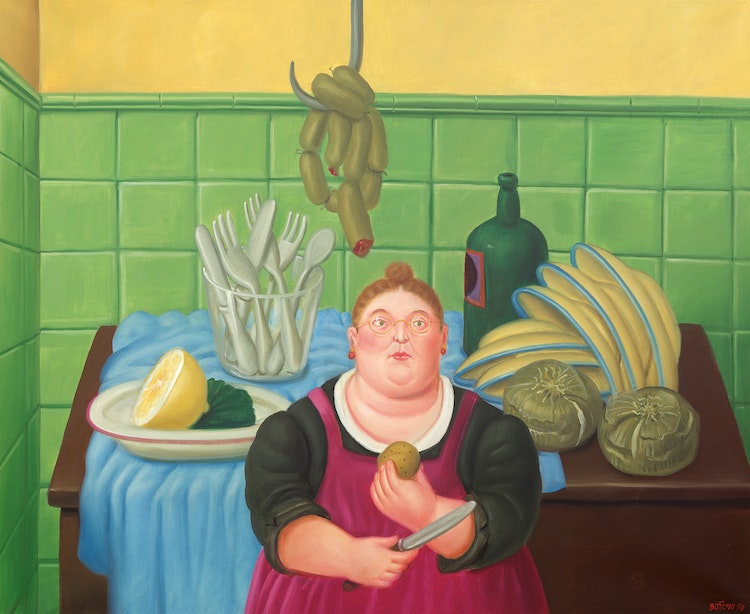Fernando Botero is a celebrated Colombian artist renowned for his paintings and sculptures that explore and experiment with the proportion and size of humans and animals. The artist’s tactile and sensual approach to the representation of rotund, whimsical figures in his paintings is a hallmark of his singular style. Consistently manipulating space and perspective, Botero is influenced by his studies of the Italian Old Masters and discovery of modern artistic movements, such as Abstract Expressionism. Botero remains connected to the artistic culture of Latin America in his oeuvre, inspired by Spanish master painters and Mexican muralists, while exposure to modernist influences have expanded his painterly practice.

In “The Kitchen”, Fernando Botero has created a sense of unease with his placement of a lone female figure directly in the center of the composition. The expression on the figure’s face is unreadable. Botero has captured the figure in the middle of the simple culinary act of peeling a potato with knife in hand, frozen by the intrusion of the viewer’s gaze. She is one of the artist’s characteristic voluminous matronly figures and is depicted in one of the most important locations in a home, the kitchen.
The table behind the female figure presents an abundant still life, set against vibrant green tiles. Fresh sausages hang on a meat hook to dry just above a glass vase filled with knives, forks and a single spoon. A large bottle of wine and a collection of yellow dishes are stacked, ready to be used for serving. Two large, juicy onions and a perfectly ripe lemon that has been sliced in half complete the still life arrangement, all presented on top of a gathered blue tablecloth.
John Sillevis writes: “There is certainly a reference to the masterpieces of Dutch seventeenth-century still life in Botero’s predilection for ‘la nature morte’. Botero is able to create the most extraordinary effects in his still lifes. He inserts a sense of menace or uneasiness into an arrangement of fruits and flowers. In Dutch art of the Golden Age, still life painting also had different layers of meaning.” Dutch genre painting was not simply a depiction of ‘everyday life’, but incorporated elements to convey moral overtones, remarking upon the vanities of worldly pleasures and the dangers of vice.
Botero’s paintings of the 1990s were often explorations of the still life in various forms, employing painterly devices and drawing upon the thread of Dutch genre painting. The overt symbolism of “The Kitchen” is revealed through the various objects Botero has chosen to include. The sliced lemon can be read as sourness or bitterness, but it can also serve as a symbol of ephemerality or the passage of time. The word for onion comes from the Latin uniothat, meaning oneness or unity, and the bottle of wine, which is always associated with the divine, may also symbolize prestige, uniqueness, wealth, and integrity.
Botero’s quintessential use of flat, bright colours and boldly outlined forms in this painting are characteristic of his signature style, while the inclusion of foods found in a traditional Colombian kitchen add a layer of nostalgia to this monumental painting. “The Kitchen” captures Botero’s enduring fascination with the tradition of still life painting, presenting the art form as current and contemporary.

